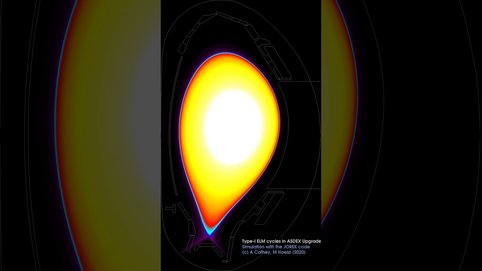For the first time: Realistic simulation of plasma edge instabilities in tokamaks
Trigger and course of plasma instability explained / agreement with the experiment
Among the loads to which the plasma vessel in a fusion device may be exposed, so-called edge localised modes are particularly undesirable. By computer simulations the origin and the course of this plasma-edge instability could now be explained for the first time in detail.
Edge Localised Modes, ELMs for short, are one of the disturbances of the plasma confinement that are caused by the interaction between the charged plasma particles and the confining magnetic field cage. During ELM events, the edge plasma loses its confinement for a short time and periodically throws plasma particles and energy outwards onto the vessel walls. Typically, one tenth of the total energy content can thus be ejected abruptly. While the present generation of medium-sized fusion devices can cope with this, large devices such as ITER or a future power plant would not be able to withstand this strain.
Computer simulation of the ELM instabilitiy
Experimental methods to attenuate, suppress or avoid ELMs have already been successfully developed in current fusion devices (see PI 3/2020). After extensive previous work, it has now been possible for the first time by means of computational simulations to identify the trigger responsible for the explosive onset of these edge instabilities and to reconstruct the course of several ELM cycles – in good agreement with experimentally observed values. A publication accepted in the scientific journal “Nuclear Fusion” explains this important prerequisite for predicting and avoiding ELM instabilities in future fusion devices.
The ELM instability builds up at the plasma edge after a quiet phase of about 5 to 20 milliseconds – depending on the external conditions – until in roughly half a millisecond, between 5 and 15 percent of the energy stored in the plasma is flung onto the walls. Then the equilibrium is restored until the next ELM eruption follows.
The plasma theorists around first author Andres Cathey of IPP, who come from several laboratories of the European fusion programme EUROfusion, were able to describe and explain the complex physical processes behind this phenomenon in detail: as a non-linear interplay between destabilising effects – the steep rise in plasma pressure at the plasma edge and the increase in current density – and the stabilising plasma flow. If the heating power fed into the plasma is changed in the simulation, the calculated result shows the same effect on the repetition rate of the ELMs, i.e. the frequency, as an increase of the heating power in a plasma experiment at ASDEX Upgrade tokamak: experiment and simulation are in agreement.
Although the processes take place in a very short time, their simulation requires a great deal of computing effort. This is because the simulation must resolve into small calculation steps both the short ELM crash and the long development phase between two ELMs – a calculation problem that could only be solved with one of the fastest supercomputers currently available.
For the simulations the JOREK code was used, a non-linear code for the calculation of tokamak plasmas in realistic geometry, which is being developed in European and international cooperation with strong contributions from IPP.
Original publication
